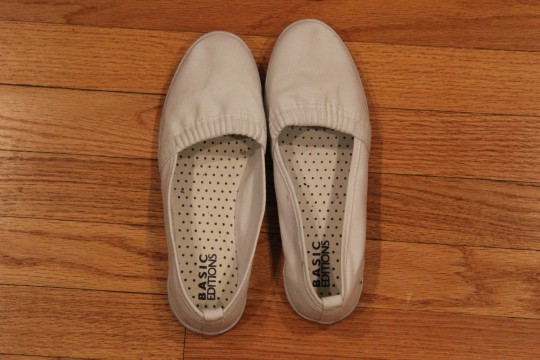RIT is a brand of clothing dye that’s been around since the 1930s. It turns drab-colored clothes and accessories into bright works of art. See below how to do a basic stove top dye job.
You can go from these:
To these:
costs about $3 per box, and you can find it almost everywhere in the U.S.—fabric stores, craft stores, or places like Target. It comes in boxes of powder and bottles of liquid, and either kind works the same way. It’s such a cheap and fun way to transform your wardrobe.
Here’s what you’ll need to get started:
- Something to dye: choose a white, off-white, or beige item of clothing made of natural fiber (cotton, wool, silk, linen), a blend of natural fibers (like a cotton/linen blend), nylon, or rayon. RIT dye doesn’t work very well on clothing made of 100% polyester, acrylic, leather, fake-leather, or acetate. Items that dye especially beautifully are: vintage slips, underwear of any kind, fabric purses, wool sweaters, T-shirts, socks, most pants, and leggings.
- RIT dye in whatever color you fancy.
- A BIG pot (like two gallons) you don’t care about and can put nasty chemicals in (i.e., you’re not gonna eat out of it—ever).
- A spoon or chopstick for stirring
- White vinegar
- Salt
- Rubber gloves—you don’t want to get this stuff on your hands, or they will be a weird color for a very long time.
- For mess prevention: paper towels, a sponge, and a bowl to hold your stir-spoon.
So now that we have our materials, let’s dye this elegant-yet-boring purse I found at a garage sale for a dollar!
Step One:
Fill your pot ¾ full with water. Turn your stove burner on, around a medium heat.
Step Two:
Examine your item. What’s it made of? If it’s made of a not-from-nature fabric (like nylon), add one cup of white vinegar. If it’s made of a natural fiber, like this silk purse, add one cup of salt to the water.
Step Three:
Carefully tear open the box of RIT dye. This is where you want to use EXTREME caution. Don’t let little grains of dye spill anywhere. Dump the whole package into the now-hot, but not-yet-boiling water in your pot. If you’re using liquid RIT dye, pour in half the bottle. Stir.
Step Four:
Gently drop your item into the pot. Poke it down with a spoon, until everything is covered with dye.
 Step Five:
Step Five:
The water will start to boil. Turn the flame down low, and let everything simmer, uncovered, for 30 minutes, stirring it often to make sure everything dyes evenly. You can dye more than one item at a time if you’re so inclined—I’m also dyeing a vintage slip in this picture, along with my purse.
 Step Six:
Step Six:
Turn off the stove. Using two spoons or your gloved hand, carefully lift the item you’re dyeing out of the pot and drop it in the kitchen sink. PLEASE NOTE: I have a stainless-steel sink that dye doesn’t affect. If you have a worn enamel or porcelain kitchen sink, take your item to the sink in the laundry room where you live. This is also where you can dump your dye water. If you don’t have a laundry sink, you can carefully dump the dye water into a cellar or basement floor drain or a shiny, non-worn porcelain toilet, and then carry out step seven over your now-empty pot in the kitchen sink.
Step Eight:
Hang up your item somewhere to dry, making sure to put an old towel underneath, where it drips.
Step Nine:
Come back when it’s dry and go, “OMIGOD!!!!” and shriek a little because it looks so cool.
Follow me on Facebook
Source: Rookiemag – Krista














